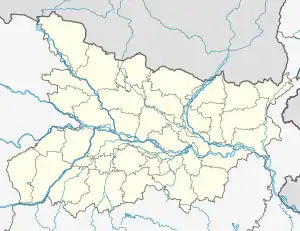Kulharia
कुल्हड़िया | |
|---|---|
Village | |
| Kulharia | |
 Kulharia Location of Kulharia in Bihar  Kulharia Kulharia (India) | |
| Coordinates: 25°20′00.004″N 86°45′53.179″E / 25.33333444°N 86.76477194°E | |
| Country | |
| State | Bihar |
| District | Khagaria |
| Subdistrict | Parbatta |
| Government | |
| • Type | Gram Panchayat |
| • Body | Kulharia Gram Panchayat |
| • Mukhiya | Smt. Vibha Devi |
| • Sarpanch | Smt. Shobha Devi |
| Area | |
| • Total | 4.64 km2 (1.79 sq mi) |
| Elevation | 42 m (138 ft) |
| Population (2011) | |
| • Total | 13,024 |
| • Rank | 2nd in Parbatta Subdistrict |
| • Density | 2,800/km2 (7,300/sq mi) |
| • Literacy Rate | 68.18% |
| • Gender Ratio | 866/1,000 |
| Demonym | Bhagalpuri |
| Language | |
| • Official | Hindi |
| • Additional official | English |
| • Regional | Angika (Maithili)[1] |
| Time zone | UTC+5:30 (IST) |
| Postal Index Number | 851216 |
| STD Code | 06245 |
| Vehicle registration | BR-34 |
Kulharia is a village in the Parbatta Subdistrict of Khagaria district, Bihar. It is 1 km from the bank of river Ganga and 5 km from the Subdistrict headquarter Parbatta. Maheslet More and Salarpur Chowk are the two major Bus Stops/Stands in Kulharia.
More Information
- Kulharia: A Promising Village in the Parbatta Subdistrict
Kulharia is a village located in the Parbatta subdistrict of Khagaria district, Bihar state, India. It is situated on the banks of the Ganges River, about 5 kilometers from the subdistrict headquarters of Parbatta and 50 kilometers from the district headquarters of Khagaria.
The village has a population of 13,024 people, out of which 6,980 are male and 6,044 are female. The literacy rate of the village is 68.18%, with 73.80% of males and 61.56% of females literate. The gender ratio in the village is 866 females per 1000 males.
The language spoken in Kulharia is also changing over time. The younger generation is more likely to speak Hindi and English, as these languages are seen as more prestigious. However, Angika remains the language of the home and the community, and is still widely spoken in Kulharia.
The main occupation of the people of Kulharia is agriculture. Other occupations include fishing, livestock rearing, and small businesses. The village has three primary school, two middle school, and two high schools, which provide a good education for the children of the village. There are also a number of private institutions in the village, which offer additional educational opportunities.
The village has a post office, a bank and four to five cashpoints/CSPs of different banks, which provide basic financial services to the villagers. The village is also home to a number of temples and a mosque, which provide a place for religious worship.
The village is governed by a panchayat, which is a local self-government body. The panchayat is responsible for providing basic services to the villagers, such as water, sanitation, and healthcare.
Kulharia is a relatively well-developed village, this is the most developed place after Parbatta in Parbatta Subdistrict. But there are still some challenges that the village faces. One of the biggest challenges is poverty. Many of the villagers live below the poverty line and struggle to make ends meet. Another challenge is the lack of healthcare. There is only one health sub-center in the village, which is not always able to meet the needs of the villagers.
Despite the challenges that it faces, Kulharia is a village with a promising future. The village is well-connected to the rest of the country and has a number of resources that can be used to improve the lives of the villagers. With the right investment and support, Kulharia can become a thriving community.
Here are some specific examples of how the village can be improved:
- The government can provide more financial assistance to the villagers to help them lift themselves out of poverty.
- The government can build more schools and hospitals in the village to improve the quality of education and healthcare.
- The villagers can work together to improve the sanitation in the village.
- The villagers can start businesses to generate income and create jobs.
With hard work and dedication, the people of Kulharia can create a better future for themselves and their village.
References
- ↑ Masica, Colin P. (9 September 1993). The Indo-Aryan Languages. Cambridge University Press. p. 12. ISBN 978-0-521-29944-2.